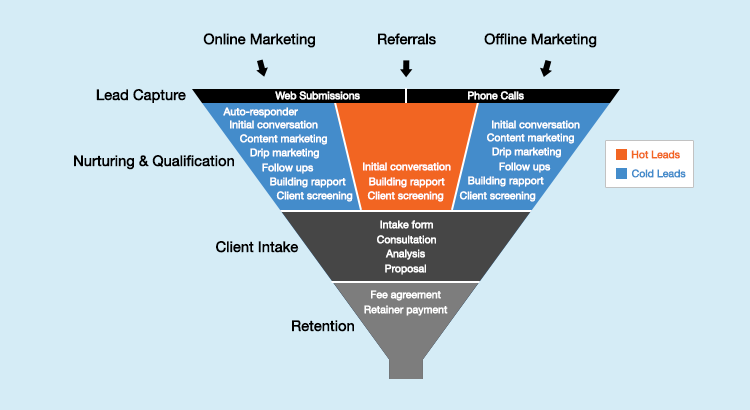Every law firm wants more leads, but the truth is, most already have plenty of them. The real problem? They’re not converting.
Visitors browse your website, fill out a form, maybe even call once, and then disappear.
That’s where legal intake funnel optimization comes in.
A well-designed intake funnel doesn’t just collect leads, it guides, qualifies, and converts them into paying retainer clients. In this article, we’ll break down how to create a seamless, data-driven intake process that turns web traffic into real cases.
What Is a Legal Intake Funnel?
A legal intake funnel is your law firm’s conversion engine, the step-by-step journey that transforms a website visitor into a signed client.
Think of it like this:
Traffic → Lead → Qualified Prospect → Consultation → Retainer Client
When optimized, this funnel automates engagement, improves communication, and makes clients feel valued before they even sign with you.
Why Law Firms Lose Leads in the Intake Process
Before we optimize, let’s identify the leaks.
- Slow Response Times – 78% of leads hire the first attorney who contacts them.
- Unclear Next Steps – Visitors don’t know what happens after submitting a form.
- Poor Intake Follow-Up – Many firms only call once, then move on.
- Complex or Outdated Forms – Long, clunky forms cause abandonment.
- No CRM or Automation – Leads get lost without proper tracking.
Every small delay or friction point costs potential revenue, and for personal injury or accident cases, those losses can be huge.
Step 1: Map Your Law Firm’s Client Journey
Start by visualizing every touchpoint from first click to signed retainer.
Typical funnel stages include:
- Awareness – The visitor finds you through SEO, ads, or referrals.
- Engagement – They visit your website, read content, or click an ad.
- Conversion – They fill out a form, use live chat, or call your office.
- Qualification – Intake staff or automation filters viable cases.
- Consultation – The attorney follows up and secures a retainer.
Mapping this helps identify where leads drop off, so you can plug those leaks.

Step 2: Optimize Your Website for Conversions
Your website is the top of your intake funnel. A few small improvements can double your conversions.
✅ Simplify Contact Forms
- Ask only for essential info: name, phone, email, and case type.
- Use progress bars for multi-step forms.
- Add reassurance: “Your information is 100% confidential.”
✅ Add Multiple Conversion Points
- Sticky “Free Consultation” buttons
- Click-to-call phone links on mobile
- Live chat or chatbot widgets
✅ Highlight Social Proof
- Client testimonials and case results
- “As featured in…” logos
- Badges (State Bar, AVVO, Super Lawyers)
✅ Optimize Page Speed and Mobile UX
Slow pages kill conversions. Compress images, use caching, and ensure your site loads within 3 seconds.
Step 3: Automate Your Intake Response
Speed wins in intake, and automation makes it possible.
Use automation tools like Zapier, Lawmatics, or Clio Grow to:
- Instantly send confirmation emails or texts when someone fills out your form.
- Automatically create a new contact in your CRM.
- Notify intake staff via Slack or email for immediate follow-up.
Example automation:
“When a lead submits a contact form → add to Clio Grow → send SMS:
‘Thanks for reaching out. Our team will contact you within 15 minutes.’”
Automation ensures you never miss an opportunity, even outside office hours.
Step 4: Qualify Leads Before the Consultation
Not every lead is a fit. Filtering early saves time and resources.
Create a Pre-Screening System:
- Accident date
- Case type (e.g., injury, employment, family)
- Fault party identified?
- Medical treatment started?
Use chatbots or smart forms that ask these questions automatically.
Once qualified, leads can be routed directly to intake staff or attorneys.
Step 5: Nurture Unconverted Leads
Many prospects won’t hire you immediately. Maybe they’re waiting on insurance, still injured, or comparing firms.
That’s why lead nurturing is essential.
Best Practices:
- Send a personalized email series explaining the process.
- Share educational blogs (like “What to Do After a Car Accident”).
- Follow up every 48–72 hours until contact is made.
Marketing automation tools like ActiveCampaign or HubSpot make this easy, keeping your brand top-of-mind until the lead is ready to retain you.
Step 6: Simplify the Retainer Signing Process
Once the client agrees, don’t let paperwork slow you down.
Modern solutions:
- E-Signatures via DocuSign, HelloSign, or Clio Grow.
- Automated Retainer Templates, prefilled with client data.
- Secure Payment Links, for deposits or retainers.
Streamlined onboarding improves your close rate and leaves a lasting professional impression.
Step 7: Track Every Step of the Funnel
You can’t improve what you don’t measure.
Use analytics tools to track:
- Form completion rates
- Lead response times
- Consultation-to-retainer conversion rates
- Cost per qualified lead
Visualize your funnel using a CRM dashboard or Google Data Studio to pinpoint weak areas.
How AI Enhances Legal Intake Funnels
Artificial intelligence is changing how firms capture and convert leads.
1. Smart Chatbots
AI chatbots handle first contact 24/7, asking relevant questions and booking consultations automatically.
They integrate with your CRM via tools like Zapier.
2. Predictive Lead Scoring
AI analyzes behavior patterns to predict which leads are most likely to hire.
That means your team focuses on high-intent prospects first.
3. Voice Intake and Call Analysis
Tools like Smith.ai or CallRail record and transcribe calls, AI then identifies call quality, lead intent, and missed opportunities.
4. Personalized Marketing
AI tracks user behavior to deliver tailored website messages, improving engagement and conversion rates.
Funnel Optimization Mistakes to Avoid
Even great firms make costly funnel mistakes. Avoid these common pitfalls:
- No Dedicated Landing Pages – Sending ad traffic to your homepage wastes conversions.
- Ignoring Mobile Users – Over 65% of legal searches happen on mobile.
- One-and-Done Follow-Ups – Persistence converts.
- Unclear CTAs – Every page should clearly state the next step.
- Failure to A/B Test – Test headlines, colors, and CTAs monthly.
Continuous optimization turns your funnel into a self-improving system.
Example: A High-Converting Law Firm Intake Funnel
Here’s a proven 5-step model many top-performing firms use:
- Google Ad / SEO Result → Landing page with a clear CTA
- Lead Form Submission → Auto-response email + SMS
- CRM Integration → Intake staff notified instantly
- Consultation Scheduling → Automated calendar booking
- Digital Retainer Signing → Client onboarded within hours
This process creates a frictionless experience for both clients and your team.
Benefits of an Optimized Legal Intake Funnel
- Faster Lead Response → Higher conversion rates
- Improved Client Satisfaction → Builds loyalty and referrals
- Better Team Efficiency → Less manual work
- Higher ROI on Marketing → Fewer wasted ad dollars
- Data-Driven Growth → Clear insight into what’s working
In short, optimization turns your marketing spend into measurable growth.
Future Trends in Legal Intake
The next generation of intake systems will blend AI, CRM, and voice technology into one seamless experience. Expect:
- AI assistants that complete intake over chat or phone.
- Real-time lead routing to available attorneys.
- Predictive analytics identifying top revenue sources.
- 360-degree client views across every marketing channel.
Firms adopting these tools early will dominate their local markets.
Final Thoughts
A legal intake funnel isn’t just a marketing concept, it’s the backbone of a profitable law practice.
When optimized correctly, it converts web visitors into clients efficiently and predictably.
To recap:
- Map your intake stages.
- Automate responses and follow-ups.
- Simplify retainer signing.
- Continuously test and measure results.
With the right strategy and tools, your law firm can transform its intake funnel into a powerful client-acquisition engine.
Ready to optimize your intake funnel and sign more clients automatically?
👉 Apply for Your FREE Discovery Call
Let Law Pro Nation help you design a conversion-optimized intake system that runs on automation, not guesswork.


